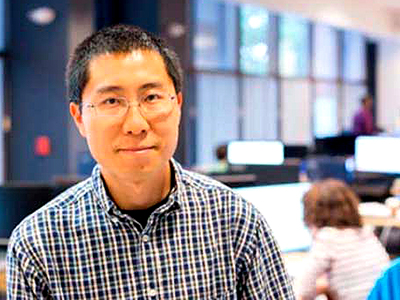
August 20, 2014
Brianna Goldberg
Biotech entrepreneur David He (ElecE 0T5) found himself in good company today: MIT Technology Review just named him to its list of Innovators Under 35.
It’s a title the Edward S. Rogers Sr. Department of Electrical & Computer Engineering alumnus shares with past honourees such as Larry Page and Sergey Brin (Google), Mark Zuckerberg (Facebook), Jack Dorsey (Twitter) and Jonathan Ive (designer of the iPod and iPad), to name a few.
So what market disrupting innovation has He produced to get added to this list of game-changers?
“We are still in stealth mode,” he said about the startup, Quanttus, launched out of his PhD research at MIT.
Curious users clicking through to the Quanttus website will find a welcoming interactive space. It invites users to ask such questions as: “How can I improve my focus?” and “How do I reduce my stress level?” They’ve been testing their product at Massachusetts General Hospital and raised $22 million in venture capital. And yet – what does it all mean?
The MIT Technology Review explains Quanttus’ core as a “watch-like gadget” that “gives a more direct view of the heart’s mechanical performance than an ECG can, capturing the strength and timing of a person’s heartbeats.”
“This could be the first time that we have gained access to an unprecedented amount of continuous vital signs data in real-life settings. These data may lead to new discoveries about our heart and how our lifestyles affect our body,” said He. “Our long-term vision is that unforeseen and preventable health events will be a thing of the past.”
“Over the years, we’ve had success in choosing young innovators whose work has been profoundly influential on the direction of human affairs,” said Jason Pontin, editor-in-chief and publisher of Technology Review. “We’re proud of our selections and the variety of achievements they celebrate, and we’re proud to add David He to this prestigious list.”
He shared a few details of Quanttus, and how his time at U of T helped him on his path to entrepreneurship.
What does your startup do?
Quanttus is combining next generation, wearable vital signs sensors with contextual data to extract patterns and insights, which allow us to improve our health by understanding how our lives impact our bodies at a physiological level.
How has your life changed since co-founding a Quanttus?
Since we started nearly two years ago, we have grown very rapidly and have attracted a lot of talent and attention despite the fact that we are still in stealth mode. We’ve been hard at work perfecting our product, performing clinical studies, and analyzing tons of human data. I’m particularly excited about our clinical study results and the accuracy we’ve achieved compared with clinical standards.
How will your startup change the lives of our readers?
Instead of one doctor’s visit per year, we are looking at half a million vital signs readings per person per day. This is the first time that we have had access to such an unprecedented amount of vital signs data in real-life settings. These data will lead to new discoveries about our heart and how our lifestyles affect our body. Our long-term vision is that one day, our devices will help make unforeseen and preventable health events a thing of the past.
What motivates you?
I look forward to going to work every day because of the amazing people who work at Quanttus. Here, people come from diverse backgrounds ranging from cardiology, engineering, data science, to user experience. It’s a wonderful feeling to work with like-minded people towards a common goal: improving people’s lives, and hopefully one day, saving lives.
How did U of T help you develop your concept?
The rigorous classes at U of T gave me a solid foundation of electrical engineering upon which my future work is based, whether it’s bioelectricity, circuit theory or signal processing. It’s a world-class learning environment where I met some of the best teachers and the brightest classmates that I know.
Tell me a bit about the people at U of T who’ve mentored or inspired you.
Professor Andreas Veneris and Professor Khoman Phang, introduced me to the pursuit of academic research and the joy of creating something that has not been done before. This carries with me to this day. Professor Berj Bardakjian taught me the class “Cellular Bioelectricity”, which inspired me to explore the multidisciplinary field between human physiology and electrical engineering.
You’ve just been named one of MIT’s Innovators Under 35. When you started at U of T, was being a noted innovator always part of your plan?
To be honest, I’ve never imagined I’d be sharing a list with such talented individuals past and present. Looking back, I would say that thinking big, not being afraid to fail, and a good amount of luck got me to where I am now.
Before we announce our product to the world, we are making sure it is well tested for accuracy and quality. We can’t wait for it to be in people’s hands and for people to start benefiting from our product as soon as possible. Stay tuned!
More information:
Marit Mitchell
Senior Communications Officer
The Edward S. Rogers Sr. Department of Electrical & Computer Engineering
416-978-7997
marit.mitchell@utoronto.ca